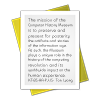Title
Lanza, Lucio oral history, part 2 of 2Catalog Number
102792006Type
DocumentDescription
Lucio Lanza was born in a small village in the County of Milan, Italy in 1944, the latter stages of WWII. He was the fifth of five children. The family later moved to southern Italy for a few years before returning to Milan when Lucio was 12. His high school was a “classical” high school, so his education until age 18 included eight years of Latin, five years of Greek, eight years of history, etc. His parents considered education very important, so all the children went to college.Despite his classical education, he found math very easy and decided to pursue engineering at a technical university in Milan. It was a challenging curriculum, but he did well and was one of only 11 (out of 1200) who finished in the prescribed 5 years.
He went to work for Olivetti in February 1968, where he had a variety of positions, but eventually focused on digital design working on word processing products. He was given responsibility for developing a communication protocol between machines. As time went on, he was assigned to serve as an interface with Intel, one of Olivetti’s important suppliers.
The Intel connection eventually brought him to the US in the early 1970’s, and then employment at Intel in October 1977. While at Intel he served in a number of positions, including managing the definition of the 80186 microprocessor and a number of other product management and strategy jobs relating to both microprocessors and peripherals. He was also intimately involved in the famous “Crush” program, which was Intel’s marketing initiative to combat Motorola’s success with their 68000 microprocessor.
In early 1983, Lucio decided to join a couple of other Intel alums at Daisy Systems, a startup developing one of the first CAE workstations. He entered as a low-level marketing manager, but quickly rose through the ranks to a position where he was managing the vast majority of Daisy’s product line.
About three years later, Lucio left Daisy to start his own company, EDA Systems. This company set out to build a software framework to connect disparate EDA tools together. Although technically successful, the company could not attract a large customer base.
Lucio left EDA Systems in 1989 and spent several years as both a venture capitalist with US Venture Partners and as a company strategist and consultant at Cadence Design Systems. He eventually decided to pursue the venture business, first with USVP and finally in 2001 he set up his own venture firm, Lanza Ventures. Investing largely his own money, he focuses on seed financing for companies with disruptive software in a handful of industries.
Date
2013-12-10Contributor
| Fairbairn, Doug, Interviewer |
| Lanza, Lucio, Interviewee |
Publisher
Computer History MuseumPlace of Publication
Mountain View, CAExtent
62 p.Format
PDFCategory
TranscriptionSubject
Intel; Olivetti; 80286 (Microprocessor); 80186 (Microprocessor); Daisy Systems; EDA Systems; Cadence; Comdisco; US Venture Partners; USVP; CrushCollection Title
CHM Oral History CollectionLot Number
X6804.2013Related Records
| 102746854 | Lanza, Lucio oral history, part 1 of 2 |
| 102746856 | Lanza, Lucio oral history, part 1 of 2 |
| 102746855 | Lanza, Lucio oral history, part 2 of 2 |


